يكمن مفتاح الإدارة الناجحة لزحف النطاق في إيجاد التوازن بين وضع الحدود وتشجيع الاستكشاف.
من خلال الجمع بين التفكير الإبداعي والانضباط التنظيمي، تكون الفرق في وضع يمكنها من الاستفادة من زحف النطاق لصالحها
غالبًا ما يؤدي النطاق الإضافي إلى مشاريع أكثر إثارة للاهتمام بالنسبة لك ولفريقك. لذا، بدلاً من الشعور بالإحباط، لماذا لا نتبنى زحف النطاق لمساعدتنا على البقاء رشيقين وقادرين على التكيف؟ إنها فرصة لتنمية مهاراتنا الإبداعية والتوصل إلى حلول من شأنها أن تنقل المشروع إلى المستوى التالي. ⚡️
دعنا نتحدث عن أسباب زحف النطاق ونتعلم نصائح قابلة للتنفيذ لإبقائه تحت السيطرة دون الحد من الابتكار. على طول الطريق، سنقوم بإسقاط
إدارة المشاريع
القوالب والموارد التي يمكنك استخدامها، من
المشاريع الإبداعية
لتحديثات البرامج الرئيسية

ما هو زحف النطاق؟
زحف النطاق هو ظاهرة تحدث عندما يتم إجراء تغييرات أو إضافات على الأهداف الأصلية للمشروع، إما بموافقة أصحاب المصلحة الرئيسيين ومديري المشروع أو بدونها.
في السياق الإيجابي، يمكن أن يساعد "زحف النطاق" على توسيع معايير المشروع، مما يسمح له بأن يصبح أكثر طموحًا واستكشاف إمكانيات جديدة. وفي السياق السلبي، يمكن أن يؤدي ذلك إلى تأخيرات كبيرة وزيادة النفقات وعدم رضا العملاء أو أصحاب المصلحة الآخرين.
قد يكون اكتساب الوضوح عند مواجهة المطالب المتطورة أمرًا صعبًا. ولكن إذا ذكّرنا أنفسنا بأن ذلك جزء ضروري من العملية، فإننا نسيطر على الوضع. من المهم أن نحافظ على تركيزنا وأن نكون فضوليين عند مواجهة التغييرات في الجدول الزمني للمشروع أو الميزانية. لكل عيب ميزة، هناك ميزة!
جدول يشرح عيوب ومزايا زحف نطاق المشروع
| مساوئ زحف النطاق | ✅ مزايا زحف النطاق | ||
|---|---|---|---|
| يصرف الانتباه عن الهدف الأولي للمشروع، مما يجعل من الصعب | href/blog?p=2181 تحديد أولويات المهام | %href/ | يعزز التعاون بين أعضاء الفريق |
| يؤدي إلى زيادة التكاليف وإجهاد الميزانيات بسبب المتطلبات الجديدة أو المعدلة | يفتح إمكانيات لمزيد من الحلول الإبداعية حيث يتم بناء الأفكار على المكونات الحالية | ||
| يقدم ميزات إضافية قد تتسبب في حدوث تضارب بين أصحاب المصلحة ذوي الاهتمامات المختلفة | يكشف التكاليف غير المتوقعة ومتطلبات الموارد في وقت مبكر ويمنع المفاجآت في المستقبل | ||
| قد يعني تلبية جميع الطلبات انخفاض الجودة والتفاصيل التي يتم التغاضي عنها | يزيد من رضا العملاء نظرًا لأن العملاء لديهم الفرصة لتلبية احتياجاتهم بشكل أكثر فعالية عندما يتم إشراكهم في العملية | ||
| يؤدي إلى عدم رضا أصحاب المصلحة عندما لا يتم تلبية طلباتهم | رؤى للمساعدة في تحسين المشروع وجعله أكثر كفاءة أو فعالية من حيث التكلفة في المستقبل | ||
| يمدد الجدول الزمني للمشروع ويؤدي إلى تفويت المواعيد النهائية من إضافة أعمال جديدة أو تعديل أعباء العمل الحالية | يخلق فرص عمل جديدة، حيث أن توسيع نطاق العمل غالبًا ما يفتح مجالات لتوليد إيرادات لم تكن في الحسبان من قبل |
ما الذي يسبب زحف النطاق؟
يحدث "زحف النطاق" عندما يبدأ المشروع في أن يصبح أكثر تعقيدًا أو كبيرًا بشكل غير ضروري أو يستغرق وقتًا أطول من المتوقع أثناء عملية التطوير. ويمكن أن ينشأ ذلك من عدم وجود متطلبات وأهداف واضحة للمشروع، أو عدم وجود خطة رسمية عملية إدارة التغيير .
ولكن حتى أفضل ما في الأمر خطة المشروع معرضة لخطر زحف النطاق. يمكنك اتخاذ جميع القرارات الصحيحة بأفضل النوايا. ثم يأتي ما هو غير متوقع، وعليك أن تتنقل بين مستويات أعلى من الغموض في نطاق المشروع . 🔍
والخبر السار هو أنك إذا اكتشفت العلامات مبكرًا، فستكون لديك فرص أفضل لمنع النطاق غير المرغوب فيه!
دعنا نستعرض العلامات الداخلية والخارجية الأكثر شيوعًا لـ زحف نطاق المشروع .
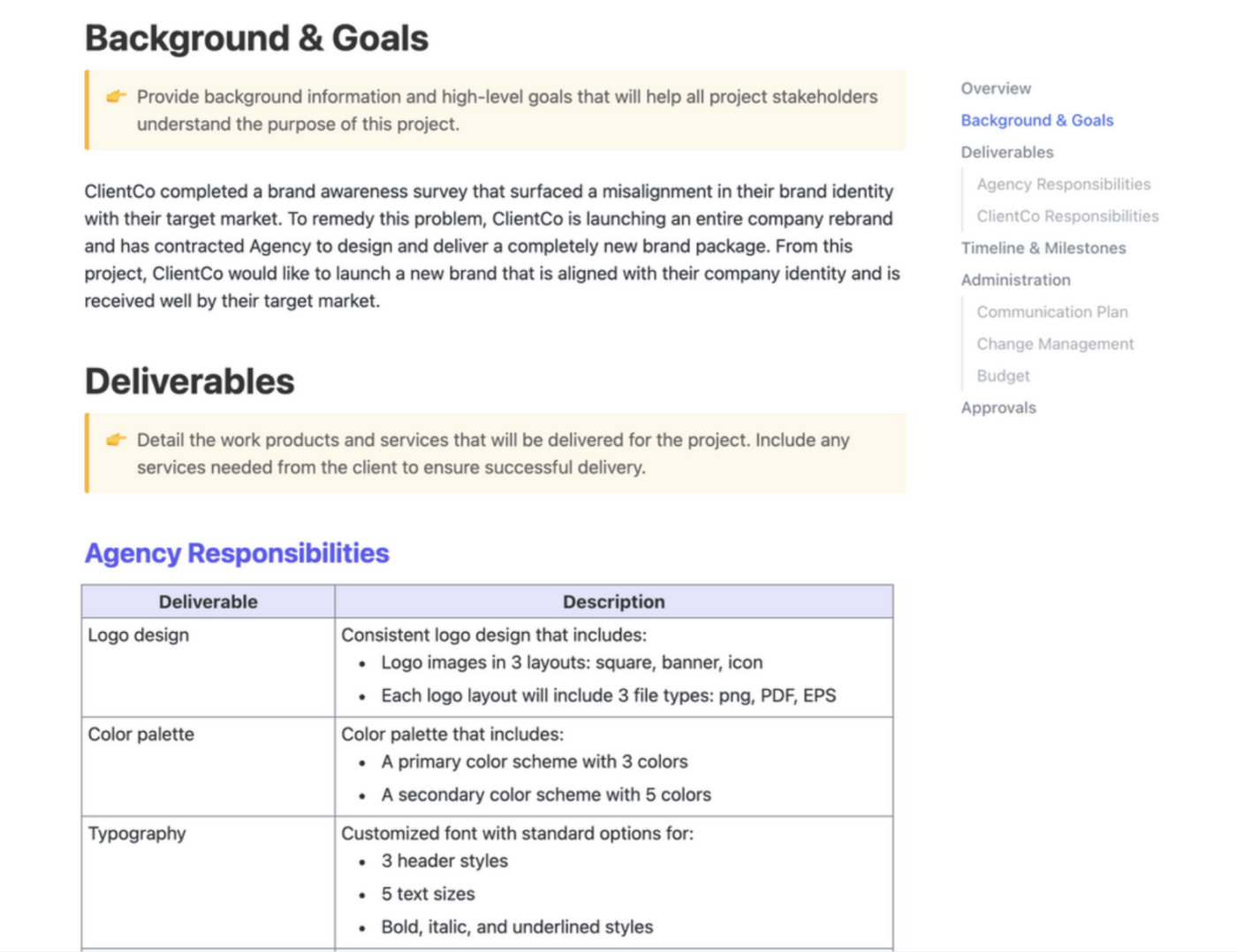
اكتب هيكل تقسيم العمل في مستندات ClickUp الديناميكية
العلامات الداخلية
المزيد من طلبات اجتماعات الفريق للتوافق على الغرض من المشروع
_أردت أن أتواصل معكم لأن الفريق يشعر ببعض الارتباك في المشروع ويمكنه حقًا الاستفادة من اجتماع آخر. نود أن نأخذ بعض الوقت للتوصل إلى فهم أفضل لما ينطوي عليه المشروع، وأين يمكننا العثور على المعلومات، وما هي أدوارنا
عند الاستجابة لطلبات اجتماع الفريق، تأكد من مراعاة التوافق مع الغرض الشامل للمشروع. اسأل نفسك "ما الذي سيساهم به هذا الاجتماع في الصورة الأكبر؟
اربط بين النقاط وأظهر كيف أن لكل بند من بنود جدول الأعمال صلة منطقية بمهمة المشروع. وبالإضافة إلى ذلك، تعرف على المدة التي يجب أن تستغرقها المحادثة للوصول إلى النتيجة المرجوة. إذا كنت تعتقد أنه يجب أن يكون الاجتماع لمدة ساعة، فحاول أن يكون لمدة 40 دقيقة! 🧑💻
كن مرنًا واستخدم أفضل ما لديك من حكم عند تقديم أفكار أو حلول بديلة يمكن أن تساعد الفريق على الاقتراب من هدفه. وأخيرًا، احرص على المتابعة مع أعضاء الفريق بعد كل اجتماع للتأكد من أن الجميع على نفس الصفحة ويدعمون استمرار التقدم نحو الهدف النهائي للمشروع.
تعلم كيفية مناقشة المنجزات المتوقعة في اجتماعك التالي اجتماع بدء المشروع !

استخدم أوامر الشرح المائل وتحرير النص المنسق لتنظيم ملاحظاتك بسرعة في ClickUp Docs
زيادة عدد المهام "المستعجلة" أو "العاجلة" ذات التقديرات الزمنية الصارمة
عندما يكون لدى المشروع مهام عاجلة ومستعجلة كل بضعة أيام، فإن ذلك يؤثر بشكل كبير على الجدول الزمني لأنه يركز على السرعة والدقة في نفس الوقت. وهذا يعني أن الفرق بحاجة إلى إيجاد طرق لإكمال المهام بسرعة وبأعلى مستوى من الجودة. 🤩
وغالبًا ما يكون هذا الأمر أصعب مما يبدو عليه ويمكن أن يؤدي إلى إكمال الفرق للمهام بعد ساعات العمل المقدرة لها، أو الاصطدام بعوائق في الطريق، أو تقدير الوقت الذي سيستغرقه إكمال المهمة بشكل خاطئ في المقام الأول. يفتح الباب الدوار للاتصالات مساحة عمل عضو الفريق أمام الإشارات و الرسائل_ المستمرة.
لتقليل عدد المهام التي يتم تعقبها بسرعة، اعمل مع أصحاب المصلحة لتحديد المواعيد النهائية المناسبة وإدارة توقعاتهم. ثم قم بتوثيق عملية لتصفية الطلبات وتفويض المهام لأعضاء الفريق. (ولكن المزيد عن هذا لاحقًا!)

إدارة الجدول الزمني للمشروع مع تواريخ البدء والاستحقاق في ClickUp
ضعف التواصل/عدم التوثيق
إن وجود توثيق واضح لكل مرحلة من مراحل المشروع أمر ضروري لنجاحه. فبدون ذلك، قد يغفل الفريق عن التفاصيل والعمليات الحاسمة للوفاء بالمواعيد النهائية وتوقعات الميزانية. لن يتمكن أصحاب المصلحة من فهم سبب اتخاذ قرارات معينة أو تتبع تقدم المشروع - مما يجعل من الصعب اتخاذ خيارات مستنيرة أو تقييم النجاح. 🏆
تسمح المعلومات والتعليمات المكتوبة بشكل جيد لأعضاء الفريق الجدد بالبدء في العمل بسرعة دون أن يؤثر ذلك على إنتاجية أعضاء المشروع الآخرين أو المديرين الآخرين.
علامات خارجية
نطاق غير محدد بشكل جيد ومفتوح للتفسير
تتسبب نطاقات المشاريع غير المحددة بشكل جيد في حدوث صداع لجميع المعنيين وتؤثر سلبًا على المواعيد النهائية والميزانيات. اطرح أسئلة حول أي بنود غير واضحة حتى يكون نطاق المشروع واضحًا وموجزًا ومفصلاً.
من الضروري وضع حواجز حماية لزيادة إنتاجية فريقك وأجواء المكتب إلى أقصى حد ممكن
رفع مستوى عملية تأهيل العميل أو صاحب المصلحة هي الخطوة الأولى.

قم بإلحاق العملاء أو راعي المشروع ببيان نطاق المشروع في مستندات ClickUp
الأحداث غير المتوقعة
لا يوجد مشروع في مأمن من الاضطرابات والأحداث غير المتوقعة التي يمكن أن يكون لها تأثير كبير على التقدم المحرز:
- غياب الموظفين غير المخطط له
- الكوارث الطبيعية
- مشاكل تقنية أو قانونية غير متوقعة
- التغيرات المفاجئة في السوق
- تغييرات الموردين
- تحديثات مايكروسوفت ويندوز التلقائية التي لم يطلبها أحد
في هذه الحالات، فإن استخدام خطة طوارئ تقلل من أي ضرر محتمل حتى يتمكن المشروع من البقاء على الهدف قدر الإمكان. من المهم أيضًا أن يتحلى جميع المعنيين بالمرونة والرغبة في إجراء تغييرات من أجل الحفاظ على تقدم المشروع إلى الأمام.
يتم إحضار أصحاب المصلحة الإضافيين في وقت متأخر
عندما ينضم أصحاب المصلحة الجدد إلى المشروع في وقت متأخر من العملية، فقد يؤدي ذلك إلى تعقيدات بسبب افتقارهم للمعرفة فيما يتعلق بالقرارات التي تم اتخاذها بالفعل.
وقد يؤدي ذلك إلى إدخال مؤشرات أداء رئيسية جديدة (KPIs) و معالم المشروع والتي قد تؤدي في نهاية المطاف إلى تغيير المنجزات الحالية. (سنغطي خطط الخلافة لاحقًا)
نصيحة احترافية استخدام مستند نطاق العمل يساعدك في الحصول على فهم واضح لمخرجات فريقك. تحميل نموذج نطاق عمل ClickUp الخاص ب ClickUp واستخدم منصتنا المجانية لإدارة أي مشروع!
## 7 نصائح لإدارة وتجنب زحف النطاق
مدير المشروع هو أول وآخر شخص يشارك في المشروع. فهم لا يشرفون فقط على كل مرحلة من مراحل المشروع لكنهم هم القائمون على العملية. 🔑
العمليات هي التي تحافظ على تنظيم الجميع وكل شيء - حتى في أكثر المواقف ضغطًا. إذا كنت تدخل مشروعًا بدون الحد الأدنى من الأنظمة المعمول بها، فسيكون من الصعب الاستفادة من زحف النطاق.
إليك سبع نصائح لإدارة زحف النطاق:
النصيحة رقم 1: اطلب استمارة استلام مكتملة لكل طلب مشروع

إنشاء عملية الموافقة على النطاق باستخدام نماذج ClickUp
صندوق البريد الإلكتروني الوارد هو أحد الأبواب المفضلة لزحف النطاق للدخول والسيطرة على مشروعك. إن مقدار الوقت الذي تقضيه في إرسال رسائل البريد الإلكتروني ذهابًا وإيابًا يستغرق ساعات عمل عميقة قيمة. فأنت ترسل قائمة من الأسئلة، وتفسر أجزاء من المعلومات، وتنتظر الردود لتضع موجزاً رسمياً.
مع نموذج استلام المشروع مثل نماذج ClickUp Forms، فإنك تحمي إنتاجية فريقك بشكل استباقي على مدار الساعة.
النماذج يمكن التنبؤ بها. النماذج تخزن البيانات. النماذج توفر المال.
عندما يقوم العميل أو صاحب المصلحة باستعراض أسئلة النموذج، فإنه يرى عملية التفكير الخاصة به تنعكس عليه. وهذا يساعدهم على استخلاص المعلومات المطلوبة التي تحتاجها كمدير للمشروع لفهم طلبهم قبل أن ينخرط الفريق في أي عمل. 👥
تم تصميم هذه الأسئلة لإعطائك بعض التوجيهات والإلهام لنموذج طلب المشروع الخاص بك:
- هل هناك أي مواد مرئية موجودة (صور، رسوم بيانية وشعارات وغيرها) تحتاج إلى استخدامها في المشروع؟
- هل هناك أي أجزاء محتوى موجودة (كتابات، تقارير، استبيانات، نتائج دراسات، إلخ) تحتاج إلى استخدامها في المشروع؟
- كيف سيتم قياس النجاح؟ قم بإدراج أي معلومات ذات صلةoKRs ومؤشرات الأداء الرئيسية للشركة.
- هل لديك قائمة بالرسائل أو النقاط الرئيسية التي سيتم تضمينها في المشروع؟
- هل هناك أي تقنيةقيود أو اعتبارات يجب أن تكون على دراية بها؟
- هل هناك أي إرشادات أو جماليات للعلامة التجارية يجب مراعاتها؟
- هل هناك أي لوائح قانونية أو معايير امتثال يجب الوفاء بها؟
- هل هناك محتوى أو مرئيات يجب استبعادها من المشروع؟
- ما هو الهدف من هذا المشروع؟
- ما هو الجدول الزمني والميزانية المخصصة للمشروع؟
- من هو الجمهور المستهدف لهذا المشروع؟
- من هم أصحاب المصلحة في المشروع؟
- متى تحتاج إلى تسليم هذا المشروع؟
- هل هذا المشروع جديد أم محدث؟
المكافأة:_
_/مرجع/ مدونة؟ p=60379_ قوالب بيان العمل* *%/%href/_
!
نصيحة رقم 2: قم بإعداد المهام في الأعمال المتراكمة قبل تعيينها
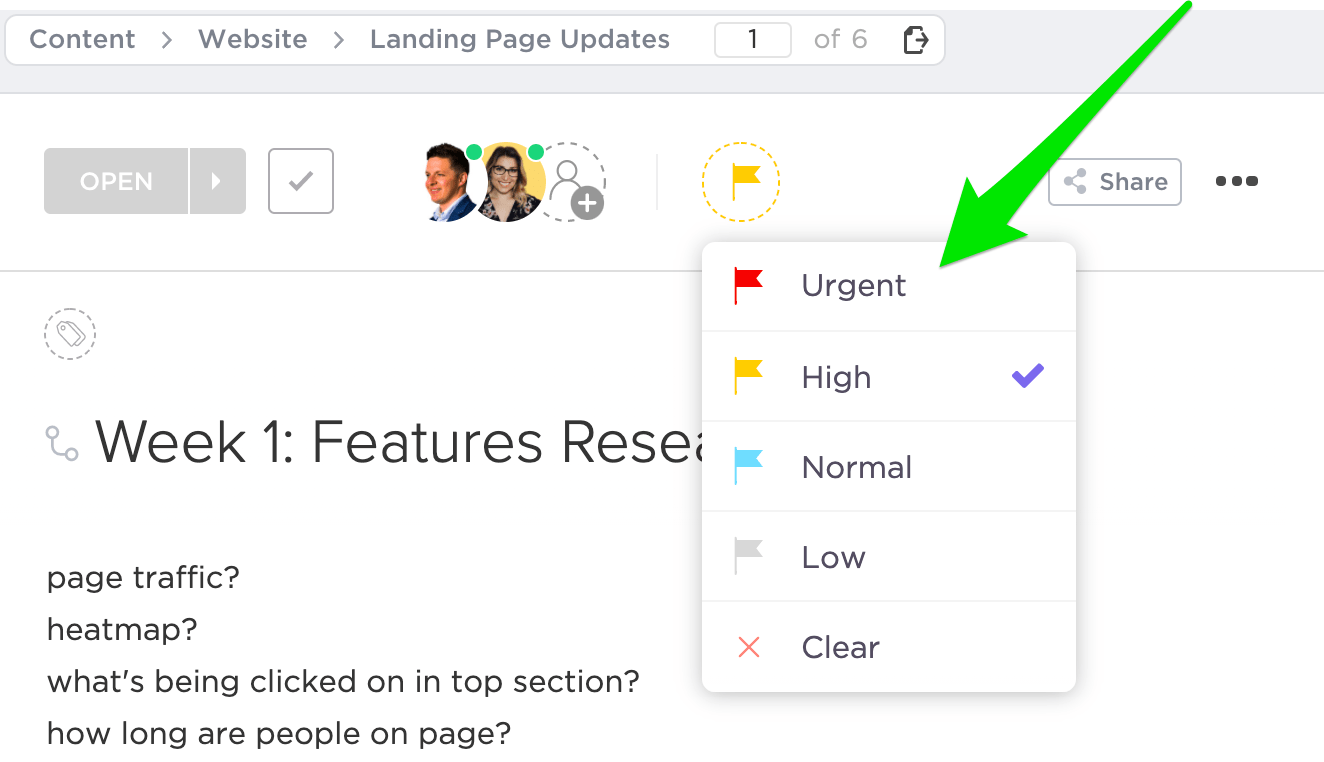
تعيين الأولويات في ClickUp لتمييز ما يجب القيام به الآن وما يمكن تأجيله
عندما تكون جميع المهام متشابهة مستوى الأولوية ، قد يكون من الصعب على أعضاء الفريق معرفة المهام التي يجب التركيز عليها أولاً. يسمح تعيين مستويات الأولوية لفرق المشروع بتنظيم العمل بناءً على معارفهم وخبراتهم وقدراتهم الفردية بحيث يتم إنجاز كل مهمة بأفضل طريقة ممكنة. 🎯
تذكرنا الأولويات بالنظر إلى ما وراء اللحظة الآنية والتخطيط للمستقبل. من خلال تحديد أهدافنا العليا، نخلق الوضوح والتركيز على كيفية تحقيق أهدافنا طويلة الأجل. يمكن أن يساعدنا ذلك في تحديد أولويات المهام، والتخلص من المشتتات، والبقاء متحمسين عند السعي لتحقيق الأهداف المهمة.
من أجل نظام الأولوية لإحداث تأثير إيجابي عبر الفرق متعددة الوظائف، اجعل هذه العملية أساسية في سير عملك. قم بإبلاغ فريق مشروعك بعلامات الأولوية التي ستساعدهم على إدارة طاقتهم ووقتهم على المهام الصحيحة كل يوم.
ومع ذلك، إذا كنت تدير مشروعًا معقدًا ذا أجزاء متعددة متحركة، فإن تحديث كل مهمة يدويًا ليس استخدامًا جيدًا لوقتك. (تلميح: زحف النطاق!) وهنا يأتي دور الأتمتة. 🤖
نصيحة رقم 3: أتمتة الأعمال المتكررة قدر الإمكان
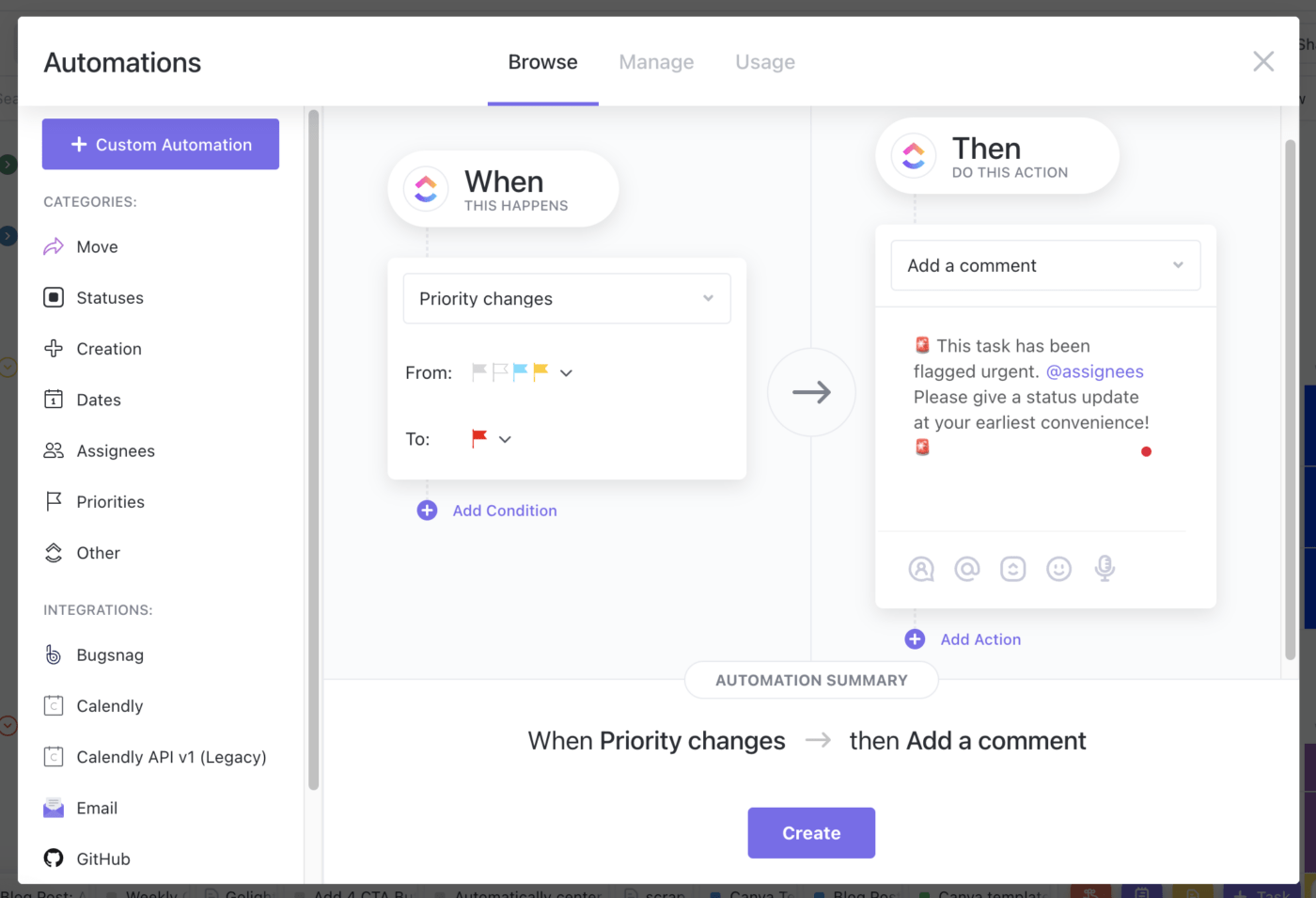
لا يتم تحديد المهام الدنيوية والإدارية في خطة المشروع، لذلك غالبًا ما يتم اعتبارها أمرًا مفروغًا منه. يضيف حفظ المهام وتنظيمها وتحديثها يدويًا كل يوم وقتًا إضافيًا للمشروع.
تتيح الأتمتة لفرق المشروع التركيز على العمل الإبداعي، بحيث لا ينشغلون بالمهام المملة - ولكن الضرورية - المتكررة. 🔁
هل أنت جديد على الأتمتة؟ إليك كيفية البدء:
- اضبط المؤقت لمدة 30 دقيقة
- اختر سير عمل واحد في خطة مشروع فريقك
- قم بتدوين كل خطوة في العملية - حتى أصغر المهام
- قم بتسليط الضوء على المهام الأكثر استهلاكا للوقت في سير العمل لإخراجها من جدول أعمالهم (على سبيل المثال، وضع علامات على المديرين لمراجعة الأصول)
- تحقق مندليل أتمتة ClickUp لبدء أتمتة سير عملك اليوم!
تعرّف على أتمتة ClickUp
نصيحة رقم 5: أنشئ عملية إدارة التغيير 
حدد خطة المشروع وعملية إدارة التغيير في مستند النقر فوق مستند ClickUp
تعد عملية التحكم في التغيير جزءًا أساسيًا من إدارة المشروع وتتضمن وضع إجراءات قياسية للتعامل مع طلبات التغيير. فبدون هذه العملية، سيؤدي زحف النطاق إلى زيادة الارتباك في المشروع.
إليك كيفية إنشاء عملية التحكم في التغيير:
1. قم بتطوير نموذج طلب تغيير: ابدأ بإنشاء نموذج يتضمن جميع التفاصيل المطلوبة لتقديم طلب تغيير
2. تحديد لجنة مراقبة التغيير: حدد الأفراد المسؤولين عن الموافقة على طلب التغيير أو رفضه. يجب أن تضم هذه اللجنة أعضاء الفريق من عدة أقسام قد تتأثر بالتغيير
3. إنشاء سير عمل مراقبة التغيير: حدد الخطوات التي يجب اتخاذها لتقييم طلب التغيير، مثل جمع الملاحظات من أصحاب المصلحة المعنيين، وتقييم مخاطر التغيير المقترح، والنظر في تأثيره على الجدول الزمني والميزانية
4. تنفيذ نظام تتبع التغيير: إعداد نظام فعال لتتبع كل طلب إلى جانب الوثائق مثل الموافقات والتعديلات وعناصر الإجراءات والأثر المترتب على ذلك
5. توثيق الإرشادات ومشاركتها: يجب أن يكون لدى جميع أصحاب المصلحة المعنيين إمكانية الوصول إلى الوثائق
6. قم بإبلاغ فريقك بالتغييرات: اشرح لماذا التغيير ضروري للمشروع، وكيف سيجعل عملهم أفضل، وأين يمكنهم العثور على موارد التغيير
مكافأة:_\
_/مرجع/ مدونة؟ ص=64555_ برنامج إدارة التغيير *%/href/_
!
نصيحة #6: إشراك فريق المشروع
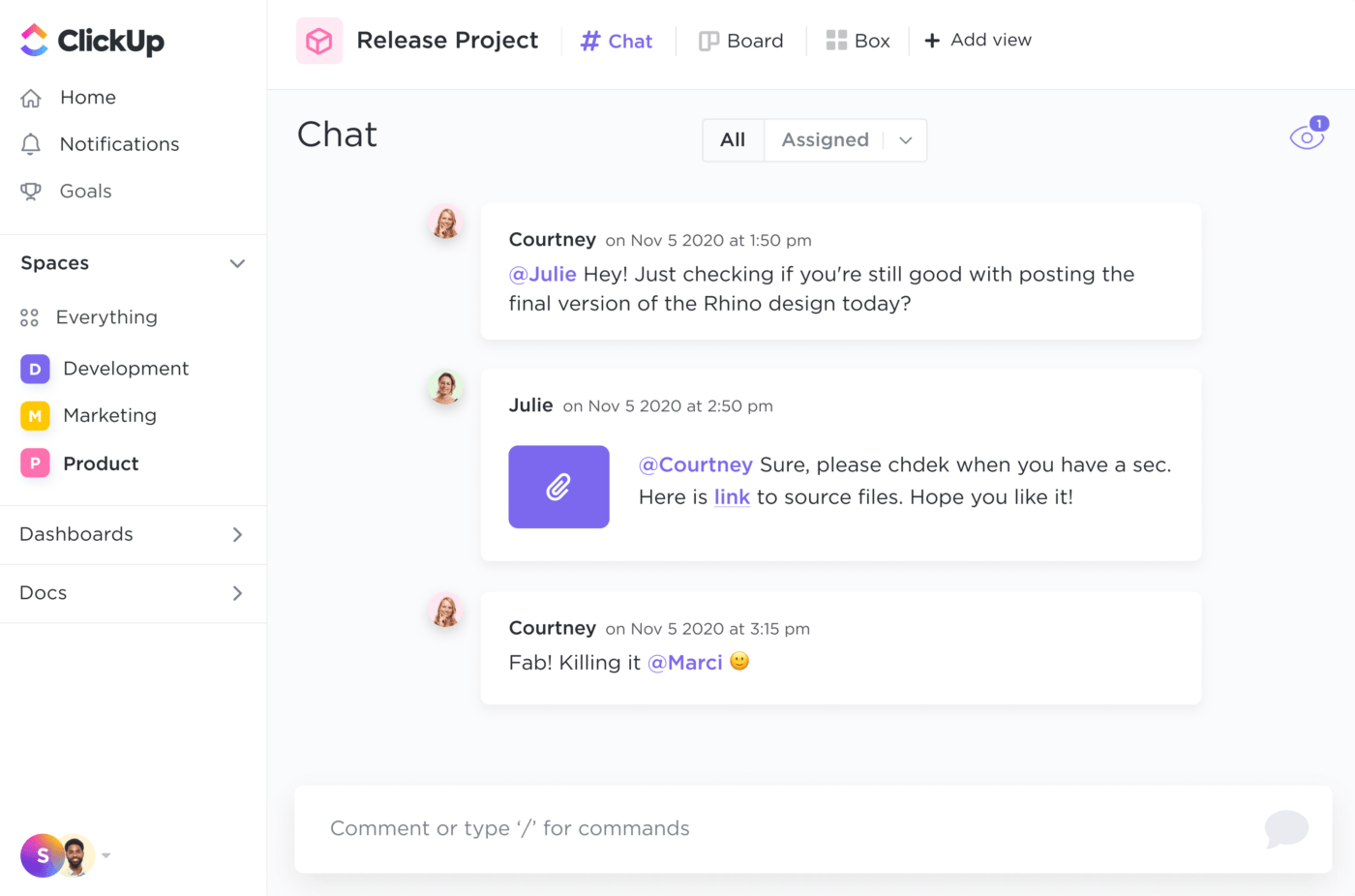
تقوم طريقة عرض الدردشة بتخزين جميع تعليقاتك في ClickUp للعثور بسرعة على أي محادثة
إن مشاركة الفريق بنشاط في القرارات والاستراتيجية أمر ضروري لنجاح إدارة المشروع. عندما يكون جميع أعضاء الفريق قادرين على تقديم إسهاماتهم، فإن ذلك يخلق شعوراً بالملكية ويزيد من التزامهم وتحفيزهم تجاه المشروع.
يمكن أن تؤدي وجهات النظر المتعددة إلى حلول جديدة وأفكار إبداعية. تسمح دعوة الفريق في مناقشات صنع القرار والاستراتيجية بتحقيق أهداف المشروع بشكل أسرع. كما أنها تسهّل إجراء محادثات حول القرارات الصعبة لأنه تم إطلاعهم على السياق بشكل مباشر. 🤝
هناك تحديات تتجاوز مهارات مدير المشروع لحلها. اعتمد على خبرات فريقك وتوجيهات فريقك لـ تفويض العمل الصحيح . ستعلم مستوى الجهد المطلوب وتقلل من زحف النطاق!
نصيحة رقم 7: إنشاء دورة تغذية راجعة شبه صارمة
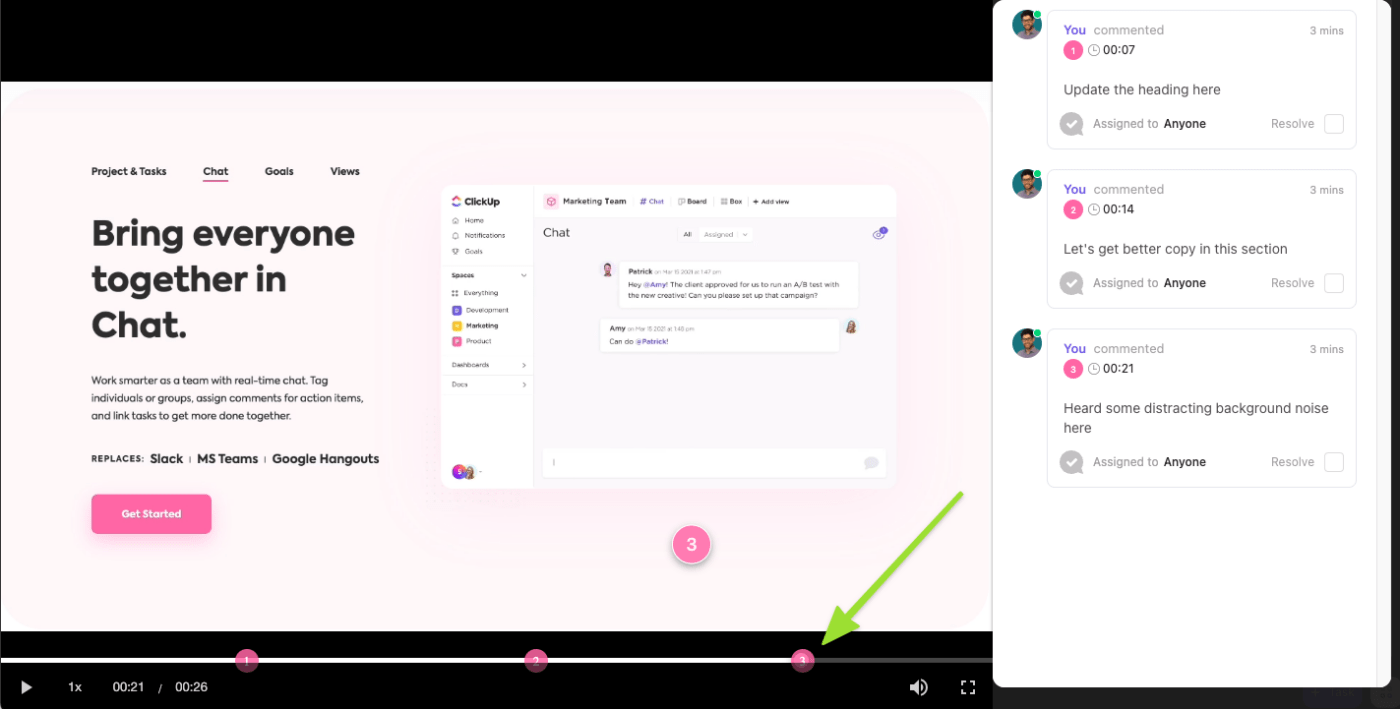
مواءمة فريق المشروع مع أدوات التعليقات التوضيحية الخاصة بـ ClickUp
يضمن الحصول على التعليقات التوضيحية في الوقت المناسب أن تتمكن الفرق من استباق أي مشاكل قبل أن تتطور إلى مشاكل كبيرة في الأوقات الأكثر أهمية في مراجعات المشروع.
إذا لم نقم بإنشاء نقاط تفتيش على طول الطريق، تزداد فرص زحف النطاق.
يجب أن تكون دورة التغذية الراجعة التي يمكن تحقيقها عبارة عن حوار بين مدير المشروع وأعضاء الفريق الذي يقوم بالعمل وأصحاب المصلحة.
والنتيجة؟ إطار عمل منظم لتقييم التقدم المحرز ومناقشة التغييرات وتحديد ما إذا كانت هناك حاجة إلى أهداف جديدة.
5 أمثلة على زحف النطاق
هذه السيناريوهات الخمسة هي أمثلة على زحف النطاق في إدارة المشروع:
- تغيير في المتطلبات: عندما يتم تغيير المتطلبات الأولية للمشروع في منتصف الطريق، مما يؤدي إلى عمل إضافي وتكلفة إضافية لجميع أصحاب المصلحة المعنيين. ومن الأمثلة على ذلك عندما يتم تكليف مطور برمجيات بإنشاء تطبيق جوال يتطلب تكامل واجهة برمجة التطبيقات، ولكن بعد بدء المشروع، يطلب العميل ميزات إضافية مثل دمج ميزة التعرف على الوجه في واجهة برمجة التطبيقات.
- تغيير في جهات الاتصال: عندما تتغير جهة الاتصال المعينة للمشروع أثناء تنفيذه وتكون لديهم متطلبات مختلفة عن تلك المحددة في الأصل. ومن الأمثلة على ذلك عندما يتم تعيين فريق هندسي لبناء جسر، ولكن في منتصف الطريق خلال عملية البناء، يتغير المدير المسؤول عن الإشراف على المشروع ويريد إضافة ميزات معينة لم تكن مدرجة في النطاق الأصلي.
- التغيير في الموارد: عندما تتغير الموارد المخصصة للمشروع، مما يؤدي إلى تكاليف إضافية أو قيود زمنية. من الأمثلة على ذلك عندما يُطلب من شركة تصميم مواقع الويب إنشاء موقع إلكتروني من الصفر، ولكن بعد أن تبدأ الشركة العمل عليه بالفعل، يطلب منها العميل شراء برامج إضافية لم تكن مدرجة في الميزانية الأولية.
- تغيير في الجدول الزمني: عندما يتم تغيير الجدول الزمني للمشروع في منتصف الطريق، مما يؤدي إلى عمل إضافي أو تكاليف إضافية لجميع المعنيين. ومن الأمثلة على ذلك عندما يُطلب من فريق تطوير البرمجيات إنشاء تطبيق يجب أن يكتمل بحلول موعد نهائي محدد، ولكن في وقت لاحق يتم إضافة المزيد من الميزات التي تستغرق وقتاً وموارد إضافية.
- تغيير في المواصفات: عندما يتم تعديل المواصفات الفنية لمشروع ما بعد البدء فيه بالفعل، مما يؤدي إلى عمل إضافي أو تكلفة إضافية لجميع أصحاب المصلحة المعنيين. ومن الأمثلة على ذلك عندما يُطلب من فريق الإنشاءات بناء مبنى مكتبي يلبي متطلبات حجم وتصميم معين، ولكن بعد ذلك يطلب العميل ميزات إضافية مثل حمام سباحة داخلي ومسرح لم تكن مدرجة في الأصل في نطاق المشروع.
## الأدوات الأساسية لإدارة زحف النطاق
الآن وبعد أن أصبح لديك الآن مورداً متاحاً من النصائح للاستفادة من زحف النطاق، ما هي الخطوة التالية؟
ضع علامة على بداية ونهاية يومك في ClickUp - منصة الإنتاجية المتكاملة التي تجمع الفرق معًا وتحقق الكفاءة التشغيلية. 💪
الـ قوالب نطاق العمل والموارد لا تتوقف هنا! لدينا عدد كبير من مكتبة القوالب لكل حالة استخدام، مفصلة على الإنترنت مركز المساعدة , ندوات عبر الإنترنت و جامعة كليك أب لمساعدتك في استخدام المنصة على أكمل وجه!
اشترك في ClickUp

